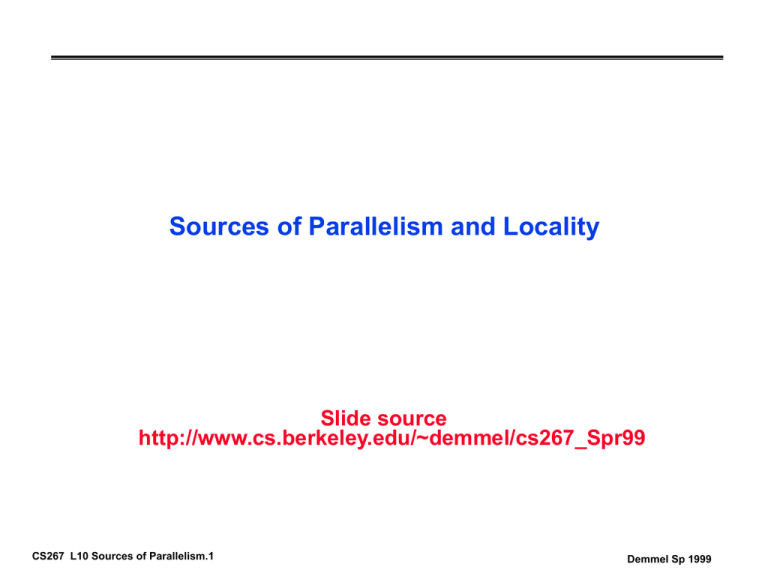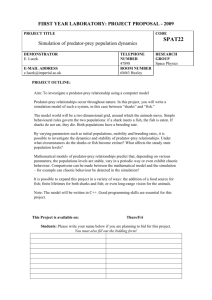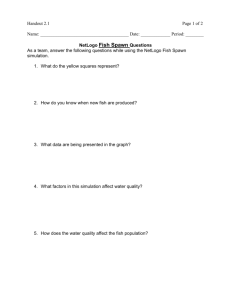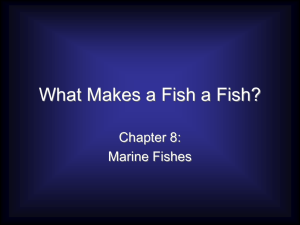CS267: Introduction
advertisement

Sources of Parallelism and Locality
Slide source
http://www.cs.berkeley.edu/~demmel/cs267_Spr99
CS267 L10 Sources of Parallelism.1
Demmel Sp 1999
Recap: Parallel Models and Machines
° Machine models
• shared memory
• distributed memory
Programming models
- threads
- message passing
- data parallel
- shared address space
° Steps in creating a parallel program
• decomposition
• assignment
• orchestration/coordination
• mapping
° Performance in parallel programs
• try to minimize performance loss from
-
load imbalance
-
communication
-
synchronization
-
extra work
Outline
° Simulation models
° A model problem: sharks and fish
° Discrete event systems
° Particle systems
° Lumped systems (Ordinary Differential Equations,
ODEs)
° (Next time: Partial Different Equations, PDEs)
Simulation Models
and
A Simple Example
CS267 L10 Sources of Parallelism.4
Demmel Sp 1999
Sources of Parallelism and Locality in Simulation
° Real world problems have parallelism and locality
• Many objects do not depend on other objects
• Objects often depend more on nearby than distant objects
• Dependence on distant objects often “simplifies”
° Scientific models may introduce more parallelism
• When continuous problem is discretized, may limit effects to
timesteps
• Far-field effects may be ignored or approximated, if they have
little effect
° Many problems exhibit parallelism at multiple levels
• e.g., circuits can be simulated at many levels and within each
there may be parallelism within and between subcircuits
Basic Kinds of Simulation
° Discrete event systems
• e.g.,”Game of Life”, timing level simulation for circuits
° Particle systems
• e.g., billiard balls, semiconductor device simulation, galaxies
° Lumped variables depending on continuous parameters
• ODEs, e.g., circuit simulation (Spice), structural mechanics, chemical
kinetics
° Continuous variables depending on continuous parameters
• PDEs, e.g., heat, elasticity, electrostatics
° A given phenomenon can be modeled at multiple levels
° Many simulations combine these modeling techniques
A Model Problem: Sharks and Fish
° Illustration of parallel programming
• Original version (discrete event only) proposed by Geoffrey Fox
• Called WATOR
° Basic idea: sharks and fish living in an ocean
• rules for movement (discrete and continuous)
• breeding, eating, and death
• forces in the ocean
• forces between sea creatures
° 6 problems (S&F1 - S&F6)
• Different sets of rule, to illustrate different phenomena
° http://www.cs.berkeley.edu/~demmel/cs267/Sharks_
and_Fish/
Sharks and Fish 1. Fish alone move continuously
subject to an external current and Newton's laws.
Sharks and Fish 2. Fish alone move continuously
subject to gravitational attraction and Newton's laws.
Sharks and Fish 3. Fish alone play the "Game of
Life" on a square grid.
Sharks and Fish 4. Fish alone move randomly on a
square grid, with at most one fish per grid point.
Sharks and Fish 5. Sharks and Fish both move
randomly on a square grid, with at most one fish or
shark per grid point, including rules for fish attracting
sharks, eating, breeding and dying.
Sharks and Fish 6. Like Sharks and Fish 5, but
continuous, subject to Newton's laws.
Discrete Event Systems
CS267 L10 Sources of Parallelism.9
Demmel Sp 1999
Discrete Event Systems
° Systems are represented as
• finite set of variables
• each variable can take on a finite number of values
• the set of all variable values at a given time is called the state
• each variable is updated by computing a transition function
depending on the other variables
° System may be
• synchronous: at each discrete timestep evaluate all transition
functions; also called a finite state machine
• asynchronous: transition functions are evaluated only if the
inputs change, based on an “event” from another part of the
system; also called event driven simulation
° E.g., functional level circuit simulation
• state is represented by a set of boolean variables (high & low
voltages)
• set of logical rules defining state transitions (and, or, etc.)
• synchronous: only interested in state at clock ticks
Sharks and Fish as Discrete Event System
° Ocean modeled as a 2D toroidal grid
° Each cell occupied by at most one sea creature
° S&F3, 4 and 5 are variations on this
The Game of Life (Sharks and Fish 3)
° Fish only, no sharks
° An new fish is born if
• a cell is empty
• exactly 3 (of 8) neighbors contain fish
° A fish dies (of overcrowding) if
• cell contains a fish
• 4 or more neighboring cells are full
° A fish dies (of loneliness) if
• cell contains a fish
• less than 2 neighboring cells are full
° Other configurations are stable
Parallelism in Sharks and Fish
° The simulation is synchronous
• use two copies of the grid (old and new)
• the value of each new grid cell depends only on 9 cells (itself plus 8 neighbors) in old
grid
• simulation proceeds in timesteps, where each cell is updated at every timestep
° Easy to parallelize using domain decomposition
P1 P2 P3
P4 P5 P6
P7 P8 P9
Repeat
compute locally to update local system
barrier()
exchange state info with neighbors
until done simulating
° Locality is achieved by using large patches of the ocean
• boundary values from neighboring patches are needed
° Load balancing is more difficult. The activities in this system are
discrete events
Parallelism in Synchronous Circuit Simulation
° Circuit is a graph made up of subcircuits connected by wires
• component simulations need to interact if they share a wire
• data structure is irregular (graph)
• parallel algorithm is synchronous
compute subcircuit outputs
propagate outputs to other circuits
° Graph partitioning assigns subgraphs to processors
•
•
•
•
•
Determines parallelism and locality
Want even distribution of nodes (load balance)
With minimum edge crossing (minimize communication)
Nodes and edges may both be weighted by cost
NP-complete to partition optimally, but many good heuristics (later lectures)
edge crossings = 6
edge crossings = 10
Parallelism in Asynchronous Circuit Simulation
° Synchronous simulations may waste time
• simulate even when the inputs do not change, little internal activity
• activity varies across circuit
° Asynchronous simulations update only when an event arrives
from another component
• no global timesteps, but events contain time stamp
• Ex: Circuit simulation with delays (events are gates changing)
• Ex: Traffic simulation (events are cars changing lanes, etc.)
Scheduling Asynchronous Circuit Simulation
° Conservative:
• Only simulate up to (and including) the minimum time stamp of inputs
• May need deadlock detection if there are cycles in graph, or else “null
messages”
• Ex: Pthor circuit simulator in Splash1 from Stanford
° Speculative:
• Assume no new inputs will arrive and keep simulating, instead of waiting
• May need to backup if assumption wrong
• Ex: Parswec circuit simulator of Yelick/Wen
• Ex: Standard technique for CPUs to execute instructions
° Optimizing load balance and locality is difficult
• Locality means putting tightly coupled subcircuit on one processor
• Since “active” part of circuit likely to be in a tightly coupled subcircuit, this
may be bad for load balance
Particle Systems
CS267 L10 Sources of Parallelism.17
Demmel Sp 1999
Particle Systems
° A particle system has
• a finite number of particles
• moving in space according to Newton’s Laws (i.e. F = ma)
• time is continuous
° Examples
• stars in space with laws of gravity
•
•
•
•
electron beam semiconductor manufacturing
atoms in a molecule with electrostatic forces
neutrons in a fission reactor
cars on a freeway with Newton’s laws plus model of driver and
engine
° Reminder: many simulations combine techniques
such as particle simulations with some discrete
events (Ex Sharks and Fish)
Forces in Particle Systems
° Force on each particle can be subdivided
force = external_force + nearby_force + far_field_force
° External force
• ocean current to sharks and fish world (S&F 1)
• externally imposed electric field in electron beam
° Nearby force
• sharks attracted to eat nearby fish (S&F 5)
• balls on a billiard table bounce off of each other
• Van der Wals forces in fluid (1/r^6)
° Far-field force
• fish attract other fish by gravity-like (1/r^2 ) force (S&F 2)
• gravity, electrostatics, radiosity
• forces governed by elliptic PDE
Parallelism in External Forces
° These are the simplest
° The force on each particle is independent
° Called “embarrassingly parallel”
° Evenly distribute particles on processors
• Any distribution works
• Locality is not an issue, no communication
° For each particle on processor, apply the external
force
Parallelism in Nearby Forces
° Nearby forces require interaction => communication
° Force may depend on other nearby particles
• Ex: collisions
• simplest algorithm is O(n^2): look at all pairs to see if they collide
° Usual parallel model is domain decomposition of physical domain
° Challenge 1: interactions of particles near processor boundary
• need to communicate particles near boundary to neighboring processors
• surface to volume effect means low communication
• Which communicates less: squares (as below) or slabs?
° Challenge 2: load imbalance, if particles cluster
• galaxies, electrons hitting a device wall
Need to check
for collisions
between regions
Load balance via Tree Decomposition
° To reduce load imbalance, divide space unevenly
° Each region contains roughly equal number of
particles
° Quad tree in 2D, Oct-tree in 3D
Example: each square
contains at most 3 particles
Parallelism in Far-Field Forces
° Far-field forces involve all-to-all interaction =>
communication
° Force depends on all other particles
• Ex: gravity
• Simplest algorithm is O(n^2) as in S&F 2, 4, 5
• Just decomposing space does not help since every particle
apparently needs to “visit” every other particle
° Use more clever algorithms to beat O(n^2)
Far-field forces: Particle-Mesh Methods
° Superimpose a regular mesh
° “Move” particles to nearest grid point
° Exploit fact that far-field satisfies a PDE that is easy to solve on
a regular mesh
• FFT, Multigrid
• Wait for next lecture
° Accuracy depends on how fine the grid is and uniformity of
particles
Far-field forces: Tree Decomposition
° Based on approximation
° O(n log n) or O(n) instead of O(n^2)
° Forces from group of far-away particles “simplifies”
• They resemble a single larger particle
° Use tree; each node contains an approximation of descendents
° Several Algorithms
•
•
•
•
Barnes-Hut
Fast Multipole Method (FMM) of Greengard/Rohklin
Anderson
Later lectures
Lumped Systems
ODEs
CS267 L10 Sources of Parallelism.26
Demmel Sp 1999
System of Lumped Variables
° Many systems approximated by
• System of “lumped” variables
• Each depends on continuous parameter (usually time)
° Example: circuit
• approximate as graph
• wires are edges
• nodes are connections between 2 or more wires
• each edge has resistor, capacitor, inductor or voltage source
• system is “lumped” because we are not computing the
voltage/current at every point in space along a wire, just endpoints
• Variables related by Ohm’s Law, Kirchoff’s Laws, etc.
° Form a system of Ordinary Differential Equations,
ODEs
• We will refresh more on ODEs and PDEs
• See http://www.sosmath.com/diffeq/system/introduction/intro.html
Circuit Example
° State of the system is represented by
• v_n(t) node voltages
• i_b(t) branch currents
• v_b(t) branch voltages
° Equations include
• Kirchoff’s current
•
•
•
•
Kirchoff’s voltage
Ohm’s law
Capacitance
Inductance
all at time t
0
A
0
A’
0
-I
0
R
-I
0
-I
0
L*d/dt
v_n
*
C*d/dt
I
° Write as single large system of ODEs
(possibly with constraints)
i_b
v_b
0
=
S
0
0
0
Systems of Lumped Variables
° Another example is structural analysis in Civil Eng.
• Variables are displacement of points in a building
• Newton’s and Hook’s (spring) laws apply
• Static modeling: exert force and determine displacement
• Dynamic modeling: apply continuous force (earthquake)
° The system in these case (and many) will be sparse
• i.e., most array elements are 0
• neither store nor compute on these 0’s
Solving ODEs
° Explicit methods to compute solution(t)
• Ex: Euler’s method
• Simple algorithm: sparse matrix vector multiply
• May need to take very small timesteps, especially if system is stiff (i.e. can change
rapidly)
° Implicit methods to compute solution(t)
• Ex: Backward Euler’s Method
• Larger timesteps, especially for stiff problems
• More difficult algorithm: solve a sparse linear system
° Computing modes of vibration
• Finding eigenvalues and eigenvectors
• Ex: do resonant modes of building match earthquakes?
° All these reduce to sparse matrix problems
• Explicit: sparse matrix-vector multiplication
• Implicit: solve a sparse linear system
direct solvers (Gaussian elimination)
iterative solvers (use sparse matrix-vector multiplication)
• Eigenvalue/vector algorithms may also be explicit or implicit
Parallelism in Sparse Matrix-vector multiplication
° y = A*x, where A is sparse and n x n
° Questions
• which processors store
- y[i], x[i], and A[i,j]
• which processors compute
- x[i] = sum from 1 to n of A[i,j] * x[j]
° Graph partitioning
• Partition index set {1,…,n} = N1 u N2 u … u Np
• for all i in Nk, store y[i], x[i], and row i of A on processor k
• Processor k computes its own y[i]
° Constraints
• balance load
• balance storage
• minimize communication
Graph Partitioning and Sparse Matrices
° Relationship between matrix and graph
1
2
3
1 1
1
2 1
1
3
4
1
1
5
6
1
1
1
1
1
1
1
1
1
1
1
1
1
1
5 1
6
4
1
° A “good” partition of the graph has
3
2
4
1
6
5
• equal number of (weighted) nodes in each part (load balance)
• minimum number of edges crossing between (minimize communication)
° Can reorder the rows/columns of the matrix by putting all the
nodes in one partition together
More on Matrix Reordering via Graph Partitioning
° Goal is to reorder rows and columns to
• improve load balance
• decrease communication
° “Ideal” matrix structure for parallelism: (nearly) block diagonal
• p (number of processors) blocks
• few non-zeros outside these blocks, since these require communication
P0
P1
=
*
P2
P3
P4
What about implicit methods and eigenproblems?
° Direct methods (Gaussian elimination)
• future lectures will consider both dense and sparse cases
° Iterative solvers
• future lectures will discuss several of these
• most have sparse-matrix-vector multiplication in kernel
° Eigenproblems
• future lectures will discuss dense and sparse cases
• depends on student interest




